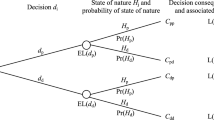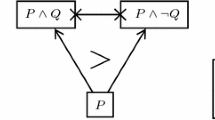Abstract
Lennart Åqvist (1992) proposed a logical theory of legal evidence, based on the Bolding-Ekelöf of degrees of evidential strength. This paper reformulates Åqvist's model in terms of the probabilistic version of the kappa calculus. Proving its acceptability in the legal context is beyond the present scope, but the epistemological debate about Bayesian Law isclearly relevant. While the present model is a possible link to that lineof inquiry, we offer some considerations about the broader picture of thepotential of AI & Law in the evidentiary context. Whereas probabilisticreasoning is well-researched in AI, calculations about the threshold ofpersuasion in litigation, whatever their value, are just the tip of theiceberg. The bulk of the modeling desiderata is arguably elsewhere, if one isto ideally make the most of AI's distinctive contribution as envisaged forlegal evidence research.
Similar content being viewed by others
Explore related subjects
Discover the latest articles, news and stories from top researchers in related subjects.References
Åqvist, L. (1992). Towards a Logical Theory of Legal Evidence: Semantic Analysis of the Bolding-Ekelöf Degrees of Evidential Strength. In Martino, A. A. (ed.), Expert Systems in Law, 67-86. North-Holland: Amsterdam.
Bolding, P. O. (1960). Aspects of the Burden of Proof. Scandinavian Studies in Law 4: 9-28.
Charniak, E. and Shimony, S. E. (1990). Probabilistic Semantics for Cost-Based Abduction. In Proceedings of the 11th Annual National Conference on Artificial Intelligence (AAAI'90), 106-111. AAAI Press: Menlo Park, CA.
Charniak, E. and Shimony, S. E. (1994). Cost-Based Abduction and MAP Explanation. Artificial Intelligence, 66: 345-374.
Ekelöf, P. O. (1964). Free Evaluation of Evidence. Scandinavian Studies in Law 8.
Fakher-Eldeen, F., Kuflik, Ts., Nissan, E. Puni, G., Salfati, R., Shaul, Y. and Spanioli, A. (1993). Interpretation of Imputed Behavior in ALIBI (1 to 3) and SKILL. Informatica e Diritto 19, 2nd series, 2(1-2): 213-242.
Henrion, M., Provan, G., Del Favero, B. and Sanders, G. (1994). An Experimental Comparison of Numerical and Qualitative Probabilistic Reasoning. In Lopez de Mantaras, R. and Poole, D. (eds), Uncertainty in Artificial Intelligence: Proceedings of the Tenth Conference, 319-326. Morgan Kaufmann: San Mateo, CA.
Jackson, B. (1998a). On the Atemporality of Legal Time. In Ost, F. and van Hoecke, M. (eds), Temps et Droit. Le droit a-t-il pour vocation de durer, 222-246. Bruylant: Brussels.
Jackson, B. (1998b). Truth or Proof?: The Criminal Verdict. International Journal for the Semiotics of Law 11(33): 227-273.
Jackson, B. (1998c). Bentham, Truth and the Semiotics of Law. (Current Legal Problems, 51.) In Freeman, M. D. A. (ed.), Legal Theory at the End of the Millennium, 493-531. Oxford University Press: Oxford.
Kuflik, Ts., Nissan, E. and Puni, G. (1991). Finding Excuses with ALIBI: Alternative Plans that are Deontically More Defensible. Computers and Artificial Intelligence 10(4): 297-325.
Kvart, I. (1994). Overall Positive Causal Impact. Canadian Journal of Philosophy 24(2): 205-227.
Martino, A. A. and Nissan, E. (eds) (1998a). Formal Models of Legal Time: Law, Computers and Artificial Intelligence, special issue of Information and Communications Technology Law 7(3).
Martino, A. A. and Nissan, E. (1998b). La prova giudiziaria: area emergente dell' “AI & Law”. Oltre la statistica forense e l'algebra delle giurie, l'integrazione di metodi AI per affrontare un dominio proteiforme. Proceedings of AI, 104-108. Padua: Italy.
Nissan, E. (1995). SEPPHORIS: An Augmented Hypergraph-Grammar Representation for Events, Stipulations, and Legal Prescriptions. Law, Computers, and Artificial Intelligence 4(1): 33-77.
Nissan, E. (1997a). Emotion, Culture, Communication. Pragmatics and Cognition 5(2): 355-369.
Nissan, E. (1997b). Notions of Place (2 parts). In Martino, A. A. (ed.), Logica delle norme, 256-302 + 303-361. SEU: Pisa.
Nissan, E. (1999). Artificial Intelligence and Criminal Evidence: A Few Topics. Proceedings of the Second World Conference on New Trends in Criminal Investigation and Evidence. Amsterdam, 10-15 December 1999. Edited by C. M. Breur et al., 495-521. Antwerpen: Intersentia.
Nissan, E. (2000). The Jama Legal Narrative. Part II: A Foray into Concepts of Improbability. Preproceedings of the AISB 2000 Symposium on AI and Legal Reasoning, 37-45 Birmingham, 17 April 2000, pp. 37-45. Now in Information and Communications Technology Law 10(1), 2001, special issue, edited by D. M. Peterson et al., pp. 39-52.
Nissan, E. (2001). Can You Measure Circumstantial Evidence? The Background of Probative Formalisms for Law. Review article on I. Rosoni, Quae singula non prosunt collecta iuvant: La teoria della prova indiziaria nell'età medievale e moderna (Giuffrè, Milan, 1995). Information and Communications Technology Law (in press).
Nissan, E. and Dragoni, A. F. (2000). Exoneration, and Reasoning About It: A Quick Overview of Three Perspectives. At Intelligent Decision Support for Legal Practice (IDS 2000). In Proceedings of the International ICSC Congress “Intelligent Systems & Applications” (ISA'2000), December 11-15, University of Wollongong, Australia, Vol. 1, pp. 94-100.
Pearl, J. (1993). From Conditional Thoughts to Qualitative Decision Theory. In Uncertainty in AI, Proceedings of the Ninth Conference, 12-20.
Santos, E., Jr. and Shimony, S. E. (1994). Belief Updating by Enumerating High-Probability Independence-Based Assignments. In Lopez de Mantaras, L. and Poole, D. (eds), Uncertainty in Artificial Intelligence: Proceedings of the Tenth Conference, 506-513. Morgan Kaufmann: San Mateo, CA.
Shimony, S. E. (1993). The Role of Relevance in Explanation. I: Irrelevance as Statistical Independence. International Journal of Approximate Reasoning 8(4): 281-324.
Shimony, S. E. and Charniak, E. (1990). A New Algorithm for Finding MAP Assignments to Belief Networks. In Bonissone, P. P., Henrion, M., Kanal, L. N. and Lemmer, J. F. (eds), Uncertainty in Artificial Intelligence: Proceedings of the Sixth Conference, 185-193. North-Holland: Amsterdam.
Schum, D. (2001). Evidence Marshaling for Imaginative Fact Investigation. Artificial Intelligence and Law 9: 165-188.
Spohn, W. (1988). A Dynamic Theory of Epistemic States. In Harper, W. L. and Skyrms, B. (eds), Causation in Decision, Belief Change, and Statistics, 105-134. D. Reidel, Dordrecht: Holland.
Author information
Authors and Affiliations
Rights and permissions
About this article
Cite this article
Shimony, S.E., Nissan, E. Kappa calculus and evidential strength: A note on Åqvist's logical theory of legal evidence. Artificial Intelligence and Law 9, 153–163 (2001). https://doi.org/10.1023/A:1017995916308
Issue Date:
DOI: https://doi.org/10.1023/A:1017995916308




